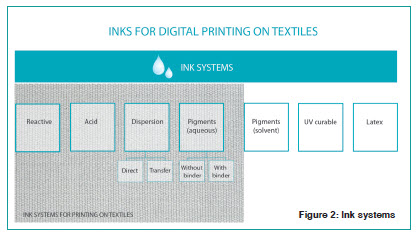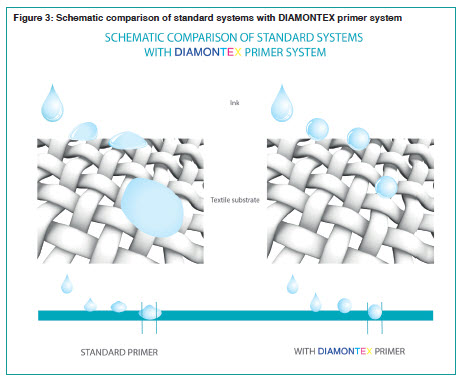1. The Advantages and Disadvantages of Digital Printing
Digital printing on to textile materials has undergone a rapid quantum leap in recent years. Through increased flexibility, quick adaptation to fashion trends, unproblematic and reproducible patterning as well as dispensing with the expensive manufacture of screens
and their storage, digital printing is increasingly gaining in importance. In addition, a design change can be implemented in digital printing with no appreciable waste or set-up times.
Colour communication via digital media presents a challenge. Among the approaches to the solution are, for example, display-screen calibration and comparison with the printed ware.
Printing without a pattern repeat is just as possible in digital printing as a unique one-off.
Digital printing offers ecological advantages in terms of dispensing with the colour mixture and with it the preparation of pigment pastes. Neither do residual pigment pastes have to be disposed of.
The new generation of machines can achieve speeds of up to 40 m/min and print widths of up to 5 metres.
The changeover of printing system from reactive to dispersion, for instance, is still proving difficult for the moment. Currently, the best solution is machines designed for the respective ink system.
Climate-controlled rooms may also be necessary. Special applications such as puff or glitter printing cannot currently be implemented in digital printing.
For the reactive printing of cellulose substrates, urea-free pretreatment systems are required, which are characterised by their low level of water and extracted-air pollution.
2. System Components of Digital Printing
The system components of fabric preparation, priming, inkjet printing with ink, print-head and machine parameters, print fixing and fastness improvement and/or functionalising play a decisive role in direct digital printing (Figure 1).
2a. Fabric Pretreatment
The first step to successful printing is a correctly implemented fabric pretreatment. The following parameters are decisive:
• absorptive capacity
• degree of whiteness
• residual preparations, freedom from size
• fabric surface, low hairiness
• antistatic properties
• edge preparation
(with elastic fabric)
2b. Priming for Inkjet Printing
The correct priming influences the quality of the following print. Substrate conditioning, wearing properties, intended use, ink systems and machine parameters all determine the method of pretreatment. These aspects must be adapted to each customer system. The following application systems are the state of the art:
• Foulard application
• foam application
• coating technique
• dipping
• template application
The inkjet pretreatment significantly influences the following assessment parameters:
Colour depth
The critical black and cyan ink pigments are the most difficult to handle in terms of colour depth or fixing. Achieving the required colour depth thus depends essentially on the priming and the ink.
Sharpness of contours
First of all, the printing accuracy has to be achieved through the application of a thickener. Inkjet inks have a very low viscosity compared to normal printing pastes for rotary or flat printing. This means that the inks are very watery and therefore begin to wander on the surface of the textile as soon as they enter it. This migration is prevented by applying a thickener.
Print through
A print through with simultaneously good contours is especially required with flag printing.
Washability
The priming should wash out after printing, leaving no residue.
Handle influence
The primer system should influence the handle as little as possible.
Flame-proofing
Pretreatment systems must not compromise the existing flame-proofing. Flame-proofing components are often integrated into the pretreatment formulas.
Degree of whiteness
The auxiliary substances used must influence the degree of whiteness as little as possible.
Residual moisture
The residual moisture after the inkjet pretreatment is decisive for re-wettability during the printing process. Residual moisture is absolutely necessary for reproducibility.
2c. Digital Printing
With digital printing the priming, ink and print-head components act together. In addition, the image definition and the machine speed must be taken into account. For a faithful print representation at least 8 different inks are used, whereby pastel tones are illustrated by means of so-called light inks. The ink systems are summarised in Figure 2.
General requirements on inkjet inks:
• purity
• particle size (with dispersion and pigment inks)
• viscosity
• surface tension
• conductivity
• stability
• thermal properties
• pH value
• foaming characteristics
• print-head cleaning costs
(ink wastage up to 30 % possible)
Textile-specific requirements on inkjet inks:
• substrate specificity
• colour tone: CMYK + spot colours + light colours
• colour strength
• fastness
• washability
Print head: The piezo DOD technology is by far the most currently widespread, whereby the droplet size is controlled by impulses of varying strengths (frequency in the Hz range).
2d. Print Fixing
Depending on the substrate and ink, the print is fixed with steam or dry heat. In the case of saturated-steam fixing of reactive prints, the reductive influences which lead to the destruction of the reactive pigments should be eliminated with anti-reduction agents. This chemistry, however, only becomes active in solution. With ‘normal’ printing, there is always a significant oversupply of pigments available and air purity is not a problem! This is not the case with inkjet printing.
The extremely small amounts of pigment are severely damaged. A defined air entrainment in the steamer is thus imperative when inkjet printing with reactive pigments.
For polyester, the dry-heat fixing method has asserted itself. In this process, dispersion inks with high sublimation and light fastness are used.
2e. Aftertreatment
Reactive prints are rinsed in a conventional way, boiled in soap and possibly cationically post-treated (often integrated in a finishing formula). In order to achieve an ultra-white background, an optical brightener is applied in the soap bath.
Advertising prints on non-combustible polyester materials are not rewashed as a rule. For printed flags and garments made from polyester a recleaning is necessary.
For PA/EL swimwear the rewashing takes place in 2 stages. In stage 1, the white background is reserved as opposed to the coloured motif; in stage 2 the pigment is fixed to correspond with the required level of fastness.
3. Intelligent Priming for Inkjet Printing
The product range DIAMONTEX has been developed for intelligent inkjet pretreatment systems. Figure 3 illustrates a schematic comparison of a system without primer (ink ‘runs’) to the DIAMONTEX primer system (right). A priming system such as DIAMONTEX contains flexible formulas which are matched to the substrate, the ink system and the usage requirements.
3a. Cellulose – Reactive Inks
The components consist of a rapid wetting agent (DIAMONTEX PAD-U), the synthetic thickening agent DIAMONTEX HD-U (easily washed out and not influencing grip) as well as the base chemicals urea, anti-reduction agent and alkali.
3b. Polyester – Direct Dispersion Printing (Figure 4)
A wide selection of variations is available here to suit the requirements. In this case the basic components also include a rapid wetting agent and a synthetic thickener.
Besides this, a special additive is used to improve contour sharpness (DIAMONTEX FLD). The colour depth is controlled through a colour-deepening agent (eg. B. DIAMONTEX CD-MI).
A sample formula is set out in the table ‘Basic formula for priming on polyester’.
For requirements in the home area (flame protection) or in the automobile sector (colour fastness) special flame-protection salts or UV absorbers are integrated into the priming formula.
3c. Polyamide – Acid and Reactive Printing
Our formula consists of rapid wetting agent, synthetic
thickener and the pH value system of acid buffer and
ammonium sulphates. This replaces the cost intensive
sodium tartrate. The system can be utilised for acid,
metal-complex and reactive inks.
4. Outlook
Digital textile printing is developing
at a rapid pace.
Apart from the increased machine speed and the consequent increase in the requirements on primers and ink systems, the current trends include the added demand for a true deep black. The flecking problem with cellulose articles in the steamer is likewise still to be solved.
The market tendencies that can be identified are illustrated graphically in Figure 5.